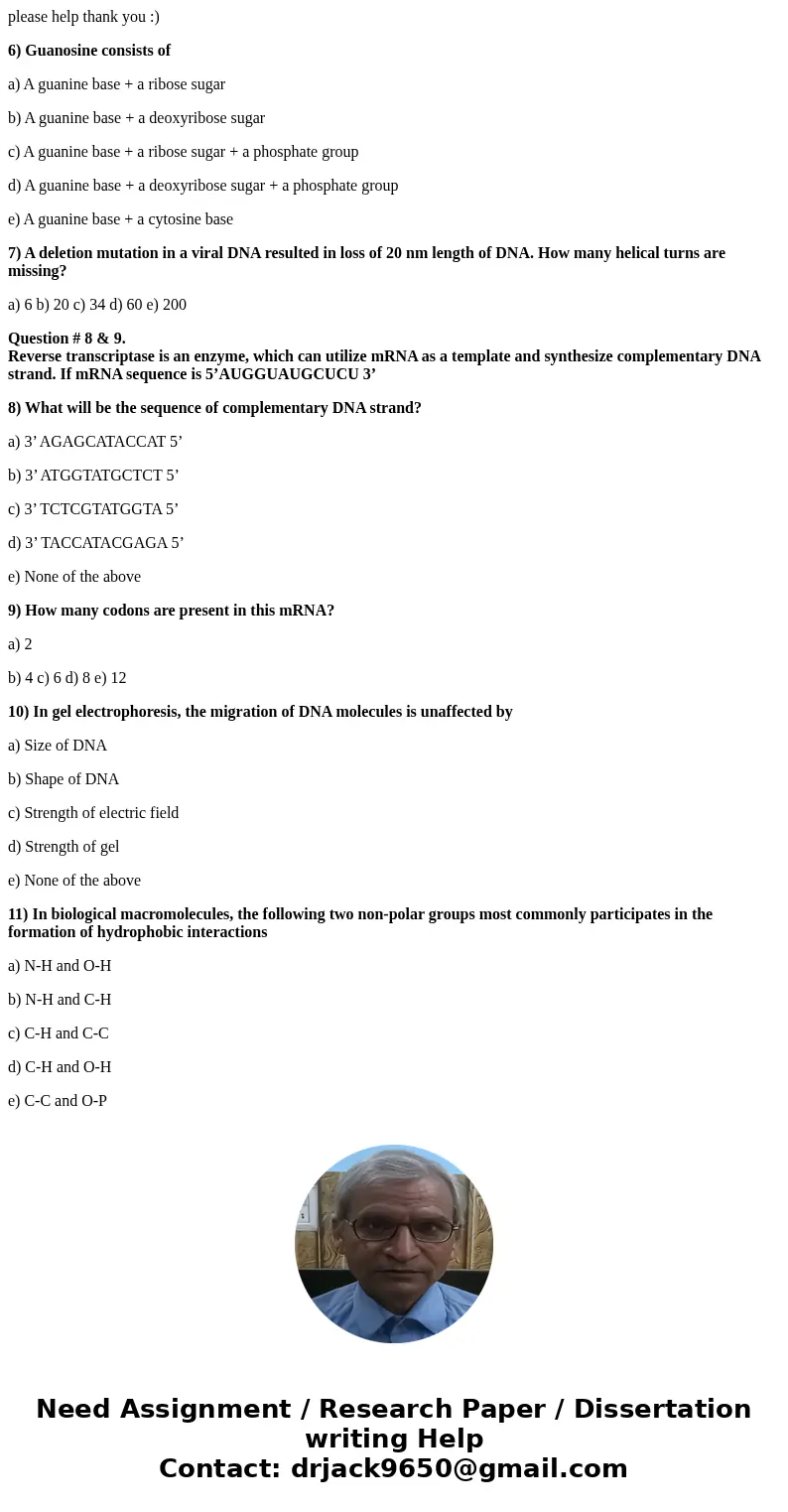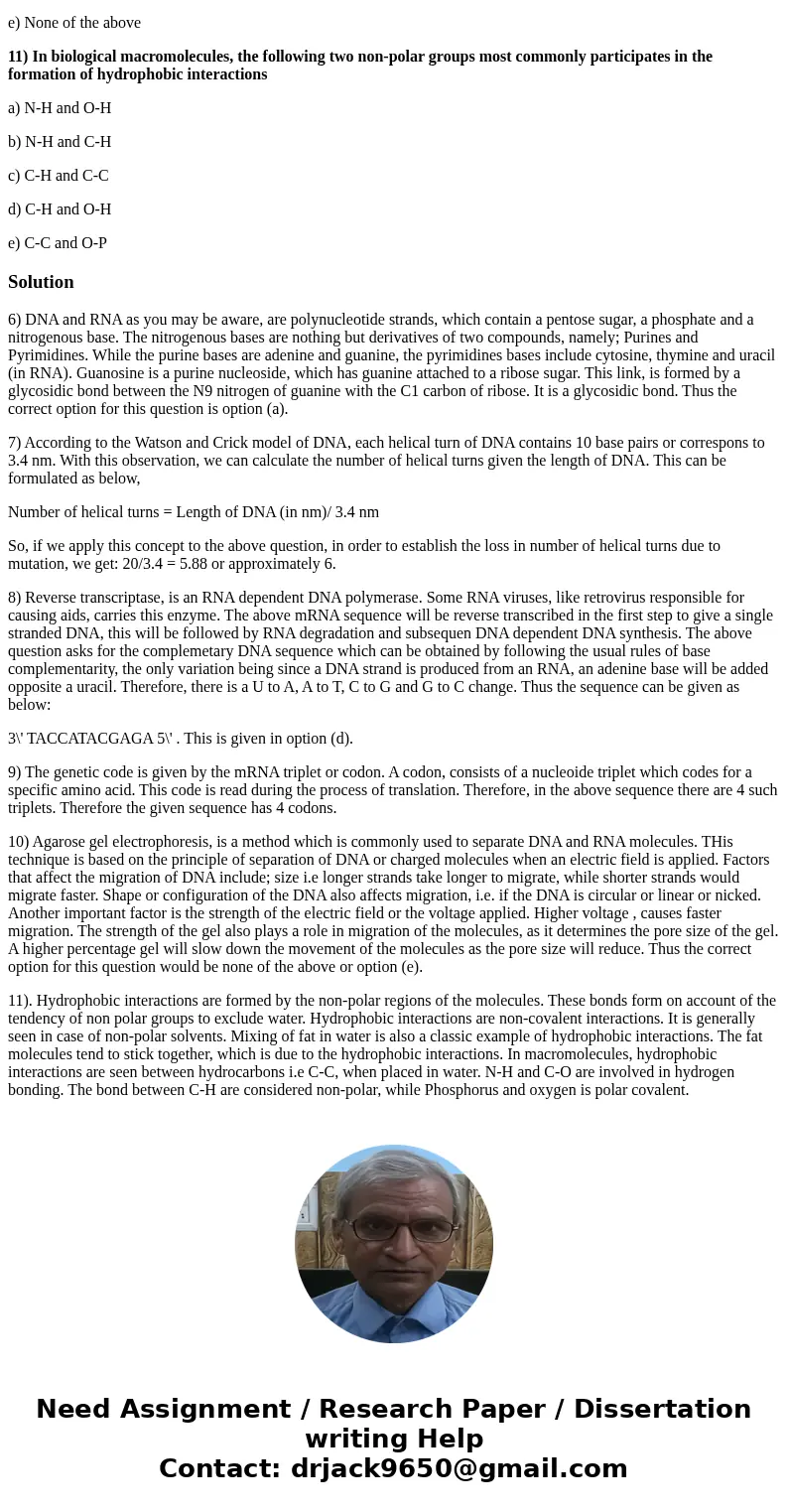please help thank you 6 Guanosine consists of a A guanine b
please help thank you :)
6) Guanosine consists of
a) A guanine base + a ribose sugar
b) A guanine base + a deoxyribose sugar
c) A guanine base + a ribose sugar + a phosphate group
d) A guanine base + a deoxyribose sugar + a phosphate group
e) A guanine base + a cytosine base
7) A deletion mutation in a viral DNA resulted in loss of 20 nm length of DNA. How many helical turns are missing?
a) 6 b) 20 c) 34 d) 60 e) 200
Question # 8 & 9.
Reverse transcriptase is an enzyme, which can utilize mRNA as a template and synthesize complementary DNA strand. If mRNA sequence is 5’AUGGUAUGCUCU 3’
8) What will be the sequence of complementary DNA strand?
a) 3’ AGAGCATACCAT 5’
b) 3’ ATGGTATGCTCT 5’
c) 3’ TCTCGTATGGTA 5’
d) 3’ TACCATACGAGA 5’
e) None of the above
9) How many codons are present in this mRNA?
a) 2
b) 4 c) 6 d) 8 e) 12
10) In gel electrophoresis, the migration of DNA molecules is unaffected by
a) Size of DNA
b) Shape of DNA
c) Strength of electric field
d) Strength of gel
e) None of the above
11) In biological macromolecules, the following two non-polar groups most commonly participates in the formation of hydrophobic interactions
a) N-H and O-H
b) N-H and C-H
c) C-H and C-C
d) C-H and O-H
e) C-C and O-P
Solution
6) DNA and RNA as you may be aware, are polynucleotide strands, which contain a pentose sugar, a phosphate and a nitrogenous base. The nitrogenous bases are nothing but derivatives of two compounds, namely; Purines and Pyrimidines. While the purine bases are adenine and guanine, the pyrimidines bases include cytosine, thymine and uracil (in RNA). Guanosine is a purine nucleoside, which has guanine attached to a ribose sugar. This link, is formed by a glycosidic bond between the N9 nitrogen of guanine with the C1 carbon of ribose. It is a glycosidic bond. Thus the correct option for this question is option (a).
7) According to the Watson and Crick model of DNA, each helical turn of DNA contains 10 base pairs or correspons to 3.4 nm. With this observation, we can calculate the number of helical turns given the length of DNA. This can be formulated as below,
Number of helical turns = Length of DNA (in nm)/ 3.4 nm
So, if we apply this concept to the above question, in order to establish the loss in number of helical turns due to mutation, we get: 20/3.4 = 5.88 or approximately 6.
8) Reverse transcriptase, is an RNA dependent DNA polymerase. Some RNA viruses, like retrovirus responsible for causing aids, carries this enzyme. The above mRNA sequence will be reverse transcribed in the first step to give a single stranded DNA, this will be followed by RNA degradation and subsequen DNA dependent DNA synthesis. The above question asks for the complemetary DNA sequence which can be obtained by following the usual rules of base complementarity, the only variation being since a DNA strand is produced from an RNA, an adenine base will be added opposite a uracil. Therefore, there is a U to A, A to T, C to G and G to C change. Thus the sequence can be given as below:
3\' TACCATACGAGA 5\' . This is given in option (d).
9) The genetic code is given by the mRNA triplet or codon. A codon, consists of a nucleoide triplet which codes for a specific amino acid. This code is read during the process of translation. Therefore, in the above sequence there are 4 such triplets. Therefore the given sequence has 4 codons.
10) Agarose gel electrophoresis, is a method which is commonly used to separate DNA and RNA molecules. THis technique is based on the principle of separation of DNA or charged molecules when an electric field is applied. Factors that affect the migration of DNA include; size i.e longer strands take longer to migrate, while shorter strands would migrate faster. Shape or configuration of the DNA also affects migration, i.e. if the DNA is circular or linear or nicked. Another important factor is the strength of the electric field or the voltage applied. Higher voltage , causes faster migration. The strength of the gel also plays a role in migration of the molecules, as it determines the pore size of the gel. A higher percentage gel will slow down the movement of the molecules as the pore size will reduce. Thus the correct option for this question would be none of the above or option (e).
11). Hydrophobic interactions are formed by the non-polar regions of the molecules. These bonds form on account of the tendency of non polar groups to exclude water. Hydrophobic interactions are non-covalent interactions. It is generally seen in case of non-polar solvents. Mixing of fat in water is also a classic example of hydrophobic interactions. The fat molecules tend to stick together, which is due to the hydrophobic interactions. In macromolecules, hydrophobic interactions are seen between hydrocarbons i.e C-C, when placed in water. N-H and C-O are involved in hydrogen bonding. The bond between C-H are considered non-polar, while Phosphorus and oxygen is polar covalent.


 Homework Sourse
Homework Sourse